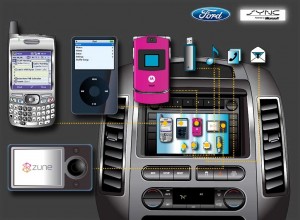
Among the many new features Ford is looking at for its Sync system, it is beta testing a live human link called Operator Assist.
When introducing its Sync infotainment system, several years ago, Ford Motor Co. boasted that after the initial cost for hardware, Sync was free to use. But that’s about to change for those who choose to subscribe to the expanded Operator Assist service, which will directly challenge General Motors’ popular OnStar system.
The Operator Assist system is designed to make it easier for motorists to locate an address and then plug it into the Sync system without having to navigate onscreen menus or learn the necessary voice commands. The new service, now undergoing beta tests with current Sync users, could also help soften criticism Ford has recently taken over the complexity of its latest in-car electronics, notably the MyFordTouch and MyLincolnTouch systems.
“Ford is committed to continuously improving the ownership experience and delivering the level of connectivity that customers want,” said Doug VanDagens, director, Ford Connected Services Solutions Organization. “By leveraging what’s available in the cloud, we continue to innovate and improve our customers’ experience without having to touch the vehicle or inconvenience the owner.”
One of the first telematics systems on the market, OnStar has traditionally emphasized the link between a motorist and a live operator, whether to open a vehicle’s locked door, check on the condition of passengers after a serious accident, or to remotely program a GM vehicle’s turn-by-turn navigation system. OnStar also offers its own, built-in hands-free calling. But those services can add up to hundreds of dollars a year in fees.
Ford says it will continue to maintain its no-charge approach with Operator Assist, despite the addition of the human connection.
During the search for a business or while receiving directions from Sync, a motorist can simply say, “operator” to make the connection. Such searches currently account for 70% of the calls to Sync, which today connect a motorist to an artificial speech system.
“Our customers asked for additional assistance in situations where their voice request was not understood,” said Sync Product Services Manager Dave Gersabeck.
Ford has turned its infotainment technology into a big selling point, and the maker reports it has helped win over a substantial number of young, tech-savvy buyers to products like the new Fiesta and Focus models.
On the other hand, problems with speech recognition and with the sometimes complex control interfaces used by Ford’s Sync-based technology has also come to bite the Detroit maker. The influential Consumer Reports magazine recently removed several vehicles equipped with MyTouch technology from its Recommended Buy list. Meanwhile, analysts with J.D. Power and Associates blame complaints about those infotainment systems for the sharp drop in Ford’s ranking in the latest Initial Quality Survey. (Click Here for more.)
“Ford dropped notably last year,” said Dave Sargent, the head of global research for Power, the California-based market research firm, adding that, “If it weren’t for MyFordTouch, we wouldn’t be talking about Ford.”
Ford officials acknowledge concerns about recent complaints, and product development chief Derrick Kuzak told TheDetroitBureau.com that the “appropriate steps” will be taken to improve usability without losing the cutting-edge functions that have made Sync so popular, overall.
The technology recently was updated to allow motorists with the latest software to link up with some smartphone apps, such as the Pandora audio system – which allows a user to create a customized music channel – and play it through the car’s speakers.
Ford is also toying with health-related features, such as the ability to tell whether a diabetic in the vehicle is experiencing shock.
And the newly-added 911 Assist challenges a basic function of OnStar. In the event of a serious accident it automatically dials emergency responders. A key difference is that all Sync services, including 911 Assist and Operator Assist, rely on pairing the car to a driver’s cellphone, rather than relying on a built-in cellphone system, as OnStar incorporates.
Given a positive response from consumers, Ford plans to roll-out Operator Assist on a broader scale.
(Infiniti offering its own high-tech, live Personal Assistant on old and new models. Click here for more.)
